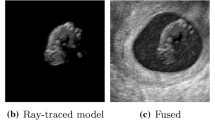Abstract
Purpose
To develop a medical ultrasound (US) simulation method using T1-weighted magnetic resonance images (MRI) as the input that offers a compromise between low-cost ray-based and high-cost realistic wave-based simulations.
Methods
The proposed method uses a novel multi-ray image formation approach with a virtual phased array transducer probe. A domain model is built from input MR images. Multiple virtual acoustic rays are emerged from each element of the linear transducer array. Reflected and transmitted acoustic energy at discrete points along each ray is computed independently. Simulated US images are computed by fusion of the reflected energy along multiple rays from multiple transducers, while phase delays due to differences in distances to transducers are taken into account. A preliminary implementation using GPUs is presented.
Results
Preliminary results show that the multi-ray approach is capable of generating view point-dependent realistic US images with an inherent Rician distributed speckle pattern automatically. The proposed simulator can reproduce the shadowing artefacts and demonstrates frequency dependence apt for practical training purposes. We also have presented preliminary results towards the utilization of the method for real-time simulations.
Conclusions
The proposed method offers a low-cost near-real-time wave-like simulation of realistic US images from input MR data. It can further be improved to cover the pathological findings using an improved domain model, without any algorithmic updates. Such a domain model would require lesion segmentation or manual embedding of virtual pathologies for training purposes.









Similar content being viewed by others
References
Jensen JA (1996) FIELD: a program for simulating ultrasound systems. In: 10th Nordicbaltic conference on biomedical imaging, pp 351–353
Camara M, Mayer E, Darzi A, Pratt P (2017) Simulation of patient-specific deformable ultrasound imaging in real time. In: Cardoso J, Arbel T, Tavares JMRS, Aylward S, Li S, Boctor E, Fichtinger G, Cleary K, Freeman B, Kohli L, Shipley Kane D, Oetgen M, Pujol S (eds) Imaging for patient-customized simulations and systems for point-of-care ultrasound. BIVPCS 2017, POCUS 2017. Lecture notes in computer science, vol 10549. Springer, Cham
Aiger D, Cohen-Or D (1998) Real-time ultrasound imaging simulation. Real Time Imaging 4(4):263–274
Ehricke HH (1998) SONOSim3D: a multimedia system for sonography simulation and education with an extensible case database. Eur J Ultrasound 7(3):225–230
Goksel O, Dehghan E, Salcudean SE (2009) Modeling and simulation of flexible needles. Med Eng Phys 31(9):1069–1078
Storve S, Torp H (2017) Fast simulation of dynamic ultrasound images using the GPU. IEEE Trans Ultrason Ferroelectr Freq Control 64(10):1465–1477
Gao H, Choi HF, Claus P, Boonen S, Jaecques S, Van Lenthe GH, Van der Perre G, Lauriks W, D’hooge J (2009) A fast convolution-based methodology to simulate 2-dd/3-d cardiac ultrasound images. IEEE Trans Ultrason Ferroelectr Freq Control 56(2):404–409
Kutter O, Karamalis A, Wein W, Navab N (2009) A GPU-based framework for simulation of medical ultrasound. In: SPIE medical imaging of the international society for optics and photonics, p 726117
Wein W, Brunke S, Khamene A, Callstrom MR, Navab N (2008) Automatic CT-ultrasound registration for diagnostic imaging and image-guided intervention. Med Image Anal 12(5):577–585
Reichl T, Passenger J, Acosta O, Salvado O (2009) Ultrasound goes GPU: real-time simulation using CUDA. In: SPIE medical imaging of the international society for optics and photonics, p 726116
Hostettler A, Forest C, Forgione A, Soler L, Marescaux J (2005) Real-time ultrasonography simulator based on 3D CT-scan images. Stud Health Technol Inf 111:191–193
Magee D, Zhu Y, Ratnalingam R, Gardner P, Kessel D (2007) An augmented reality simulator for ultrasound guided needle placement training. Med Biol Eng Comput 45(10):957–967
Burger B, Bettinghausen S, Radle M, Hesser J (2013) Real-time GPU-based ultrasound simulation using deformable mesh models. IEEE Trans Med Imaging 32(3):609–618
Insana MF, Wagner RF, Garra BS, Brown DG, Shawker TH (1986) Analysis of ultrasound image texture via generalized Rician statistics. Opt Eng 25(6):256743
Burckhardt CB (1978) Speckle in ultrasound B-mode scans. IEEE Trans Sonics Ultrason 25(1):1–6
Shams R, Hartley R, Navab N (2008) Real-Time simulation of medical ultrasound from CT images. In: Medical image computing and computer-assisted intervention—MICCAI 2008. Springer, Berlin, pp 734–741
Wagner RF, Smith SW, Sandrik JM, Lopez H (1983) Statistics of speckle in ultrasound B-scans. IEEE Trans Sonics Ultrason 30(3):156–163
Acknowledgements
This work was supported in part by TÜBİTAK TEYDEB 1505 Programme under Grant # 5130002 and in part by the Turkish Ministry of Development under the TAM Project No. DPT2007K120610. The authors would like to thank Prof. Dr. Atadan Tunacı, Assoc. Prof. Burçin Ünlü, S. Girgin, O. Mat and F. Büyükkeçeci for their support.
Author information
Authors and Affiliations
Corresponding author
Ethics declarations
Conflict of interest
The authors declare that they have no conflict of interest.
Ethical statement
Anonymized retrospective data was used for the experiments. No patient data were acquired for this study; hence, formal consent is not required.
Rights and permissions
About this article
Cite this article
Tuzer, M., Yazıcı, A., Türkay, R. et al. Multi-ray medical ultrasound simulation without explicit speckle modelling. Int J CARS 13, 1009–1017 (2018). https://doi.org/10.1007/s11548-018-1760-4
Received:
Accepted:
Published:
Issue Date:
DOI: https://doi.org/10.1007/s11548-018-1760-4




